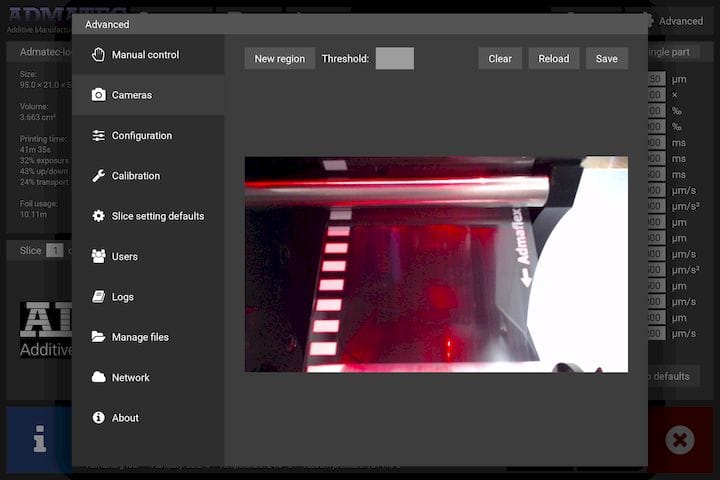![Process monitoring system for ceramic 3D printing [Source: Admatec]](https://fabbaloo.com/wp-content/uploads/2020/05/image-asset_img_5eb0913327fa9.jpg) Process monitoring system for ceramic 3D printing [Source: Admatec]
Process monitoring system for ceramic 3D printing [Source: Admatec]
Netherlands-based Admatec has introduced a rather interesting vision-based process monitoring system.
The purpose of the new system is to increase the reliability and quality of the 3D printed output on their line of ceramic and metal 3D printers. Their unique 3D printing process involves a film-based approach.
Admatec Foil Printing Process
Instead of having a vat of photopolymer resin as virtually all other resin-based 3D printers employ, Admatec’s process involves wetting the surface of a film. This film, now containing a thin layer of resin, is rolled under the DLP light engine, where a new layer is solidified.
There are significant advantages to this approach, not the least of which is that highly viscous resins can be used. Viscous resins are problematic in vat approaches because there are challenges in having the thick fluid flow into the spaces of a new layer. This slows printing, whereas Admatec’s approach avoids this effect.
You can see how their process works here:
Their new process monitoring system should be ideal for their demanding industrial clients who produce intricate ceramic and metal parts. The monitoring system involves a variety of optical sensors and intelligent software that carefully monitors the progress of each print job.
Admatec Process Monitoring Benefits
Admatec says:
“The vision-based system adds even more user control to the modular 3D printer for metal and ceramics through layer detection, foil movement and time-lapse videos of the print. The Admaflex’s patented feedstock system allowed the successful development and fast adoption of the process monitoring system, as through the Admaflex foil you can see exactly what is happening during the print process, and record it, layer by layer.
For example, if a build platform would print 180 products with just one failing during the process, the monitoring system will detect this and proceed with the other 179 parts to finalize successfully. Whereas with a more traditional approach like VAT this would mean the full run has instantly failed.”
This capability could be of significant value to clients, who are no doubt producing parts for other parties. The idea in any such installation is to keep the machine running as much as possible to produce revenue. If a machine is required to re-run a print job, then the first run’s revenue-generating time is effectively lost. This can make a 3D printer ineffective financially.
In Admatec’s example, the job to produce 180 parts would have been 99.4% successful — and revenue generating.
Admatec Process Monitoring Traceability
![Logs from the ceramic 3D printing vision-based process monitoring system [Source: Admatec]](https://fabbaloo.com/wp-content/uploads/2020/05/image-asset_img_5eb0913380854.jpg) Logs from the ceramic 3D printing vision-based process monitoring system [Source: Admatec]
Logs from the ceramic 3D printing vision-based process monitoring system [Source: Admatec]
The process monitoring system also should be of interest from a traceability point of view, as it could theoretically be possible to literally record the production of individual parts, although I am not sure Admatec offers that capability.
Similar optical monitoring systems have been implemented in a very few other 3D printing systems, typically for metal 3D printers where the cost of each job run carries significant risk if a failure occurs. But as far as we know, Admatec may be the first to implement such a system on a ceramic 3D printer.
Admatec Process Monitoring Availability
It is not clear whether the new process monitoring feature will be a standard capability on Admatec machines, or whether it is a paid option. It’s also unclear whether older Admatec units could be upgraded to incorporate the new feature.
Via Admatec

